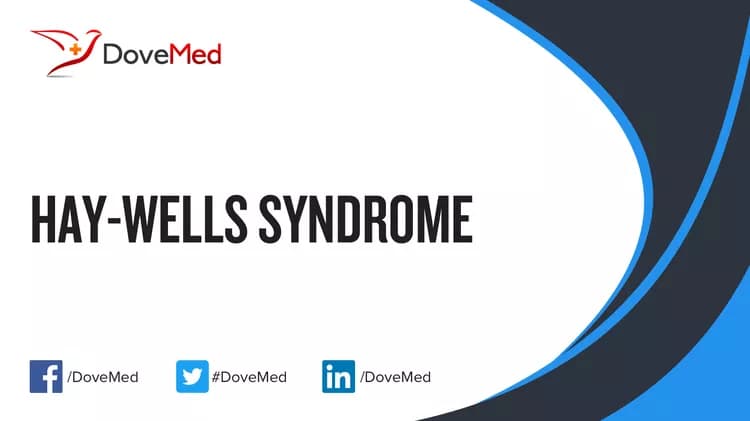What are the other Names for this Condition? (Also known as/Synonyms)
- AEC Syndrome
- Ankyloblepharon Ectodermal Defects Cleft Lip/Palate
- Ankyloblepharon-Ectodermal Defects-Cleft Lip/Palate Syndrome
What is Hay-Wells Syndrome? (Definition/Background Information)
- Hay-Wells Syndrome is a form of ectodermal dysplasia, a group of conditions characterized by abnormal development of ectodermal tissues including the skin, hair, nails, teeth, and sweat glands
- The most common feature is missing patches of skin (erosions) on the scalp, neck, hands, and feet. The skin erosions can lead to infection, scarring, and hair loss
- Other features include changes in skin coloring; misshapen or absent fingernails and toenails; malformed or missing teeth; increased sensitivity to heat; hearing loss; cleft lip and/or palate; and other facial abnormalities
- This condition is caused by mutations in the TP63 gene and is inherited in an autosomal dominant fashion
(Source: Hay-Wells Syndrome; Genetic and Rare Diseases Information Center (GARD) of National Center for Advancing Translational Sciences (NCATS), USA.)
Who gets Hay-Wells Syndrome? (Age and Sex Distribution)
- Hay-Wells Syndrome is a rare congenital disorder. The presentation of symptoms may occur at birth
- Both males and females may be affected
- Worldwide, individuals of all racial and ethnic groups may be affected
What are the Risk Factors for Hay-Wells Syndrome? (Predisposing Factors)
- A positive family history may be an important risk factor, since Hay-Wells Syndrome is an inherited condition
- Currently, no other risk factors have been clearly identified for the syndrome
It is important to note that having a risk factor does not mean that one will get the condition. A risk factor increases one’s chances of getting a condition compared to an individual without the risk factors. Some risk factors are more important than others.
Also, not having a risk factor does not mean that an individual will not get the condition. It is always important to discuss the effect of risk factors with your healthcare provider.
What are the Causes of Hay-Wells Syndrome? (Etiology)
- Hay-Wells Syndrome is caused by mutations in the TP63 gene and is inherited in an autosomal dominant fashion
(Source: Hay-Wells Syndrome; Genetic and Rare Diseases Information Center (GARD) of National Center for Advancing Translational Sciences (NCATS), USA.)
Autosomal dominant: Autosomal dominant conditions are traits or disorders that are present when only one copy of the mutation is inherited on a non-sex chromosome. In these types of conditions, the individual has one normal copy and one mutant copy of the gene. The abnormal gene dominates, masking the effects of the correctly function gene. If an individual has an autosomal dominant condition, the chance of passing the abnormal gene on to their offspring is 50%. Children, who do not inherit the abnormal gene, will not develop the condition or pass it on to their offspring.
What are the Signs and Symptoms of Hay-Wells Syndrome?
The signs and symptoms of Hay-Wells Syndrome may include:
- 2-3 toe syndactyly
- Abnormality of the nervous system
- Absent eyelashes
- Anhidrosis
- Anonychia
- Atresia of the external auditory canal
- Blepharitis
- Cleft upper lip
- Conjunctivitis
- Hyperconvex nail
- Hyperpigmentation of the skin
- Hypoplasia of the maxilla
- Hypospadias
- Lacrimal duct atresia
- Micropenis
- Nail dystrophy
- Oval face
- Patchy alopecia
- Patent ductus arteriosus
- Selective tooth agenesis
- Sparse body hair
- Vaginal dryness
Based on the frequency of symptoms observed, the following information may be noted:
Very frequently present symptoms in 80-99% of the cases:
- Ankyloblepharon
- Coarse hair
- Conductive hearing impairment
- Dystrophic fingernails
- Dystrophic toenail
- Hyperconvex fingernails
- Hypohidrosis
- Hypotrichosis
- Non-midline cleft lip
- Wide nasal bridge
Frequently present symptoms in 30-79% of the cases:
- Abnormality of dental enamel
- Conical tooth
- Generalized hyperpigmentation
- Hypodontia
- Micrognathia
- Palmoplantar keratoderma
- Sparse and thin eyebrow
- Sparse eyelashes
- Submucous cleft hard palate
- Submucous cleft soft palate
- Widely spaced teeth
Occasionally present symptoms in 5-29% of the cases:
- Abnormality of the voice
- Absent lacrimal punctum
- Clinodactyly of the 5th finger
- Delayed eruption of teeth
- Finger syndactyly
- Protruding ear
- Supernumerary nipple
- Ventricular septal defect
(Source: Hay-Wells Syndrome; Genetic and Rare Diseases Information Center (GARD) of National Center for Advancing Translational Sciences (NCATS), USA.)
How is Hay-Wells Syndrome Diagnosed?
Hay-Wells Syndrome is diagnosed on the basis of the following information:
- Complete physical examination
- Thorough medical history evaluation
- Assessment of signs and symptoms
- Laboratory tests
- Imaging studies
- Biopsy studies, if necessary
Many clinical conditions may have similar signs and symptoms. Your healthcare provider may perform additional tests to rule out other clinical conditions to arrive at a definitive diagnosis.
What are the possible Complications of Hay-Wells Syndrome?
The complications of Hay-Wells Syndrome may include:
- Severe emotional stress due to skin abnormalities and other cosmetic concerns
- Loss of hearing
- Dental abnormalities
Complications may occur with or without treatment, and in some cases, due to treatment also.
How is Hay-Wells Syndrome Treated?
There is no cure for Hay-Wells Syndrome, since it is a genetic condition. The treatment is usually given to manage the signs and symptoms and any complications that develops.
How can Hay-Wells Syndrome be Prevented?
Currently, Hay-Wells Syndrome may not be preventable, since it is a genetic disorder.
- Genetic testing of the expecting parents (and related family members) and prenatal diagnosis (molecular testing of the fetus during pregnancy) may help in understanding the risks better during pregnancy
- If there is a family history of the condition, then genetic counseling will help assess risks, before planning for a child
- Active research is currently being performed to explore the possibilities for treatment and prevention of inherited and acquired genetic disorders
Regular medical screening at periodic intervals with tests and physical examinations are recommended.
What is the Prognosis of Hay-Wells Syndrome? (Outcomes/Resolutions)
- The prognosis of Hay-Wells Syndrome is dependent upon the severity of the signs and symptoms and associated complications, if any
- Individuals with mild conditions have better prognosis than those with severe symptoms and complications
- Typically, the prognosis may be assessed on a case-by-case basis
Additional and Relevant Useful Information for Hay-Wells Syndrome:
The following DoveMed website link is a useful resource for additional information:
Related Articles
Test Your Knowledge
Asked by users
Related Centers
Related Specialties
Related Physicians
Related Procedures
Related Resources
Join DoveHubs
and connect with fellow professionals


0 Comments
Please log in to post a comment.